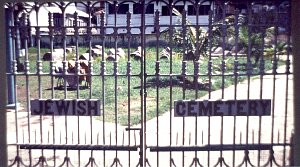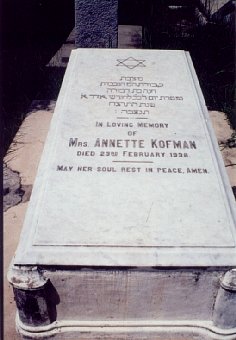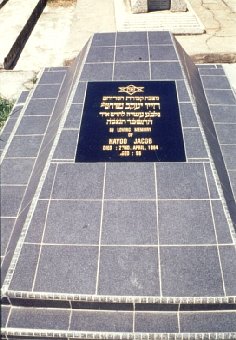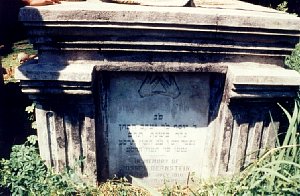|
The Jewish cemetery in Penang is believed to be the oldest single Jewish cemetery in the country, if not in the entire region. The only cemetery established solely for the once small and thriving Jewish community in Peninsular Malaysia, there may be a few Jewish graves in other non-Jewish cemeteries. The oldest legible gravestone in the Jewish Cemetery is dated 1805 with the latest in 1976. The cemetery in Penang also has one of the largest number of Jewish graves interred in one specific area, numbering around approximately 70 graves (The Northam Road Cemetery holds 95 graves), including that of a Jewish British officer killed during the Second World War. Five other "military" graves reputedly contain the remains of six Jewish servicemen killed in action on the Malay Peninsula during W.W.II. |
||
|
The overall condition of the graves themselves seems to be in a remarkable state of preservation. Apart from one or two graves that have been split open by the forces of nature, the rest of the graves are clean and generally well kept. Some of the graves are overgrown with grass, which hampered efforts to read the inscriptions. Others had been buried too close to the older graves, making it difficult to move between them. This situation is rather odd considering that there is enough space in the cemetery for at least another three score graves. Most of the tombs in the Jewish cemetery are shaped with a vaulted or gabled lid. These tombs have obviously been shaped to resemble ossuaries that may be found in Israel. A distinct feature of these uniquely shaped tombs is the fact that they often have fingertip shaped depressions of varied sizes and depth cut into the narrow sides for easy handling (Rahmani 1994: 4-6). Some of the flats, sliding lids have a shallow depression at one narrow end for this purpose as well. |
||
The perimeter of the cemetery itself is shaped in a rough "axe-head" shape, measuring approximately 200 feet by 100 feet and enclosed by 8-foot high walls that are pierced every 9 feet or so by pillars. Strong cast iron gates marked with the words "Jewish Cemetery" guard the one entrance to the cemetery. The oldest graves lie directly in front of the gates on a wide concrete base. They seem to have been set in no particular order up until the early 1930s. From then on, the graves are set in the last row near the back wall in a rough chronological order. The Cohen family graves are set aside from the rest of the graves in the northeastern corner of the cemetery.
The designs of the graves range from simple medieval alcove-shaped tomb covers to elaborately carved miniature crypt-styled edifices. Some of the inscriptions are chiseled out in Hebrew while the others are engraved or sandblasted in Latin Alphabets. The older graves have a rough uneven look to them denoting their age while the newer ones are starkly severe. The further upkeep clearly has been hampered by a lack of funds and know-how. Apart from this, the rough dwellings built around the inner perimeters of the cemetery disrupt the general sanctity of the place. This situation seems to be difficult to overcome as the caretaker appears to have settled there permanently. In many respects, the cemetery owes much of its present state of preservation from vandals and other negative influences by the constant presence of the caretaker and her family. The present caretaker, Mrs. Fatima, is bedridden and is the granddaughter of the first caretaker. She does not seem to know who owns the cemetery nor has any recollection of being told who had been given the authority to deal with any future burials. She did mention however that a few "church people" would regularly come over from Butterworth to inspect the site briefly and pay her the monthly fee of RM45 (A$22.50 - US$18) for her services. The monthly fee of RM45 or about $18 US covers the upkeep of the cemetery (cutting grass and general maintenance of the place) and has remained unchanged since the time of her grandfather. However, she has been given basic lodgings in the form of a rough hut of corrugated iron built into the side wall of the cemetery. This sparse "living area", if you may call it that, is situated immediately on the left-hand side of the gate entrance as you face the cemetery from the main road. Source: This email address is being protected from spambots. You need JavaScript enabled to view it. [September 1998] 16 names from the Register of Deaths Under Section III of Act 14 of 1856 (Dated 22nd March 1921) List of Names Taken From the Register of The Jewish Public Cemetery Jahudi Road/Jalan Zainal Abidin Transcribed On The 29th of July 1996 by Raimy Che-Ross. The data was on a web site maintained by This email address is being protected from spambots. You need JavaScript enabled to view it.. He has photos.
In 2010 I visited the Jewish Cemetery in Georgetown. I mentioned the cemetery briefly in my blog and posted some photographs online. Source: This email address is being protected from spambots. You need JavaScript enabled to view it. [March 2011]
Cemetery Photographs by This email address is being protected from spambots. You need JavaScript enabled to view it., who has more available on slides. [January 2002]
Armenian presence began in Penang in 1802. Among those from the Caucasus between the Black and Caspian Seas were Armenians Jews, who joined Cairene Jewish who preceded them. The Jewish population has vanished from Penang, leaving only Georgetown Jewish Cemetery on the former Yehudi Street, now called Jalan Zainal Maidin, as witness to their presence. The last burial was in 1978. Buried there were Manashas, Mordechais, Jacobs, Efraims, and Moses families. Source: This email address is being protected from spambots. You need JavaScript enabled to view it., Kota Kinabalu, Sabah, Malaysia [December 2001]
A small Jewish Cemetery on Jalan Zainal Abidan (Street), one block north of Jalan Macalister (Jalan means street in Malay) about 5 blocks northwest of the Komtar Office Building (a landmark impossible to miss in Georgetown). Interestingly, on the city map, the street is named Jalan Yehudi, but there was no apparent sign of that name on the streets or business addresses. I counted 106 graves (my guide said there were 104 and perhaps he was correct). Six are somewhat segregated. He said they were soldiers' graves (the inscription on at least one confirmed this). The inscriptions on about half of the markers are present and readable, some in Hebrew, and some in English. Most graves have full concrete covers over them. Some are quite elaborate structures. Some of the older ones are crumbling, but most are in good shape. Source: This email address is being protected from spambots. You need JavaScript enabled to view it., [March 13, 1997]
Names on a few of the stones that I photographed are Jacob, Schwartz, Cohen, Eisenberg, Moses, Houfswang, Ephraim, and Horn. Also mentioned in World Guide for the Jewish Traveler by Warren Freedman, E.P. Dutton Inc, NY 1984. Source: This email address is being protected from spambots. You need JavaScript enabled to view it. [March 1994]
See Encyclopaedia Judaica entry for information about Ezekiel Menassah from Baghdad, who supposedly settled in 1895 as the only Jew in the area for thirty years. He maintained Jewish observance. This information may be erroneous as many stones in the cemetery date from the early 1900s. Some appear even older. Mainly poor Jewish peddlers arrived after W.W.I. The community was evacuated to Singapore during WWII. Jews settled there after the war but only about twenty families remained by 1963 and three by 1969. Source: This email address is being protected from spambots. You need JavaScript enabled to view it.: . [date?]





